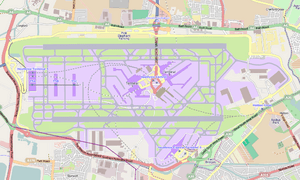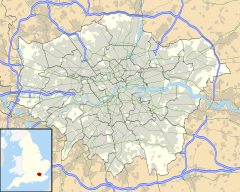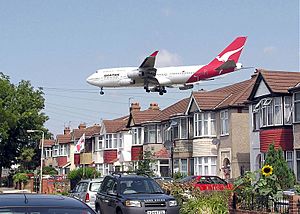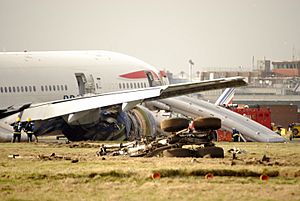Hatton, London facts for kids
Quick facts for kids Hatton |
|
|---|---|
 The Green Man pub in Hatton |
|
| OS grid reference | TQ095755 |
| London borough | |
| Ceremonial county | Greater London |
| Region | |
| Country | England |
| Sovereign state | United Kingdom |
| Post town | HOUNSLOW, FELTHAM |
| Postcode district | TW6, TW14 |
| Dialling code | 020 |
| Police | Metropolitan |
| Fire | London |
| Ambulance | London |
| EU Parliament | London |
| UK Parliament |
|
| London Assembly |
|
Hatton is a small area in London, close to London Heathrow Airport. It's split between two London boroughs: Hillingdon and Hounslow. A main road, the A30 road, runs right through it. Before 1965, Hatton was part of a county called Middlesex.
For many years, Hatton was famous for highway robbers. An old inn, The Green Man, still stands there and even has a secret hiding spot behind its chimney! A nearby road is named Dick Turpin Way, after a famous highwayman. Long ago, Hatton had pretty country houses with gardens. One was built by King Edward III and visited by King Richard II.
Hatton is still considered a small village or neighborhood of Bedfont. It's separated from Bedfont by a field and sports areas. To the north and west, you'll find big roads, warehouses, hotels, and parking lots for London Heathrow Airport. This airport area has been part of Hillingdon since 1994. To the south, Hatton connects with Bedfont and North Feltham. To the east is the River Crane, and across it is Hounslow West.
Contents
What's in a Name?
Hatton's name comes from an old Anglo-Saxon word, Hǣþtūn. This means "heath farmstead." A heath is an open area of land, often with small shrubs. Until 1819, Hatton's farms and gardens were surrounded by this kind of open land.
Hatton's Neighbors

Hatton is surrounded by other places. To the south is North Feltham. To the west and southwest is Bedfont. And to the north is Heathrow Airport. The A30 road has been the border with Hillingdon since 1994. To the northwest is Cranford. The very south part of Hatton is often called the North Feltham Trading Estate.
Heathrow Airport's Impact
Hatton has many industrial buildings that help support Heathrow Airport. The eastern part of Hatton can be quite noisy because planes are often landing or taking off. At Myrtle Avenue, there's a nice grassy area where people like to watch the airplanes. This is a popular spot for "plane spotters."
Places to Visit and What's There
Hatton Green
Hatton Green is home to a pub and restaurant called "The Green Man." Next to it is a field with horses, geese, cows, and other animals. This is part of Hounslow Urban Farm. It says it's the biggest "urban" farm in London. Most of London is very built up, so having farms like this is special.
Hatton Cross
Hatton has a small café near the green on Faggs Road. Inside Hatton Cross station, you can find a convenience store and a newsagents. There's also a bank with a car park north of Hatton Cross. A petrol station with a Subway restaurant is also nearby. A large hotel called The Atrium faces the Cross too. In the southern part of Hatton, there's a 24-hour Tesco supermarket and petrol station next to the urban farm.
Hatton no longer has a church. Its old Baptist Chapel was turned into offices in 2000. Most of the houses in Hatton are semi-detached or maisonettes built between the 1930s and 1950s. Some older buildings still exist on Green Man Lane, including an old Manor house and two other homes from the 1700s. A 17th-century blacksmith's workshop has been turned into a family home.
The main office for Air France-KLM in the UK and Ireland is at Plesman House in Hatton Cross. It opened in 2006. This office handles sales and support for the airline.
East of Hatton, there's a large lake that used to be a sand and gravel quarry. It's over 500 meters long and is now split by a new road called The Causeway.
Hatton's Past
In 1086, a powerful person named Roger de Montgomery owned some land in Hatton. This land had been held by two farmers before. Later, another small piece of land in Hatton was owned by Walter Fitz Other. It's thought that these lands eventually became part of larger estates. A priory (a type of monastery) in Hounslow also owned land in Hatton in 1382.
King Edward III seems to have built a house in Hatton called Hatton Grange. King Richard II used to rent this house from the Hounslow priory for a yearly payment.
In 1911, Hatton was a small village in a flat area. Its main street was a meeting point for several smaller roads. This made it a favorite spot for highwaymen because they could easily ambush travelers. The old inn, The Green Man, with its secret hiding spot, was perfect for them.
Two fairs, one in Bedfont and one in Hatton, used to be held each year. But they were stopped in 1881 by the government. In 1911, Hatton had a Baptist chapel and a mission room for the Church of England.
In 2008, British Airways Flight 38 had an emergency landing just before Heathrow's south runway. It passed over Hatton's Myrtle Avenue and the A30 road.
What's Changed?
North of the Great South West Road
As London Heathrow Airport has grown, it has taken up a large part of Hatton's land, especially everything north of the A30 road. Many old buildings in this area were taken down by 1949. These included:
- The Limes: A large house built around 1840.
- The Cedars: Another large house from around 1840. It had a big pond and cedar trees. The famous writer Charles Dickens sometimes visited here. Its site is now airport car parks.
- Hatton Road Farm: A farm west of Hatton Road.
- Hatton Gore: A large house built around 1840. It had a big garden with a special rock garden built by plant collector Frank Kingdon-Ward. Its site is now part of a truck depot.
- The Common: A farm.
- The Dog and Partridge: A pub.
- The Cyclist's Rest: A snack shop.
Hatton Road itself now mostly runs through the airport's restricted areas.
South of the Great South West Road
- Temple Hatton: A country house with large grounds. It was owned by Sir Frederick Pollock, 3rd Baronet. In 1899, it became an orphanage called St. Anthony's Home. It was sold in 1958 because of the increasing aircraft noise. Airport buildings now stand on its site.
- Steam Farm: This farm was special because it was the first in the area to use a steam-powered plough. Its site, along with other old buildings, is now occupied by a Gate Gourmet food service company.
- Hatton Farm: This farm had several buildings and a Mission Hall. Today, the area is mostly empty land, with some old farm buildings still visible.
Getting Around Hatton
The closest London Underground station is Hatton Cross. Many London Buses routes serve Hatton, connecting it to the airport, Hounslow, Northolt, Southall, Richmond, and Staines.
You can sometimes find free parking on Hatton Lane. However, most roads around Hatton have parking rules like red routes (no stopping allowed) or double yellow lines. Some areas are for residents only during weekdays. The Green Man pub has its own parking for customers.
For over a hundred years, until the 1840s when major railways were built, stagecoaches regularly passed through Hatton. They used the main road through Hatton to travel to places like Dorset, Devon, and Cornwall. Hatton also has a depot for Ashford Luxury Coaches, whose "Windsorian" coaches have been used to transport members of the British Royal Family.






